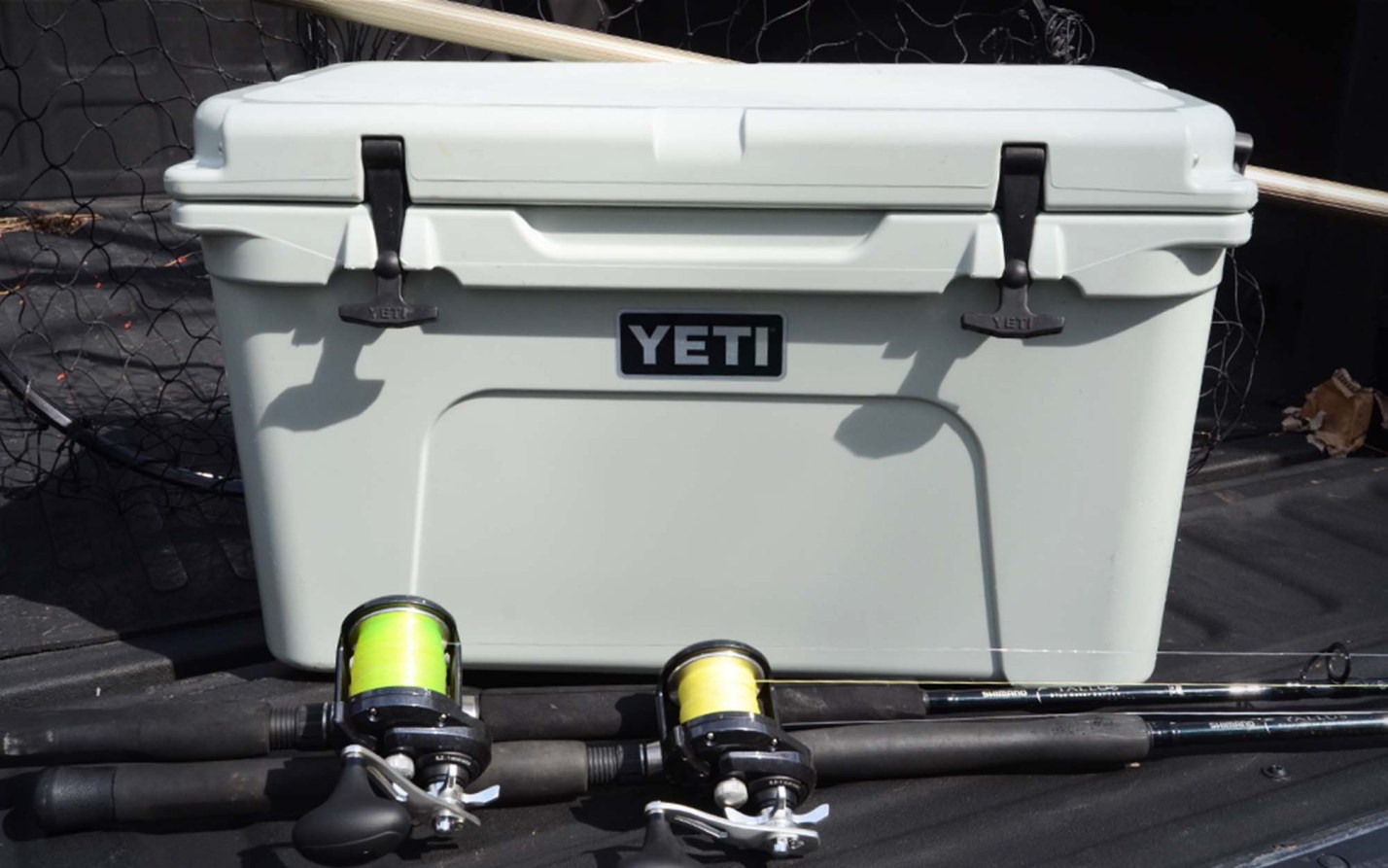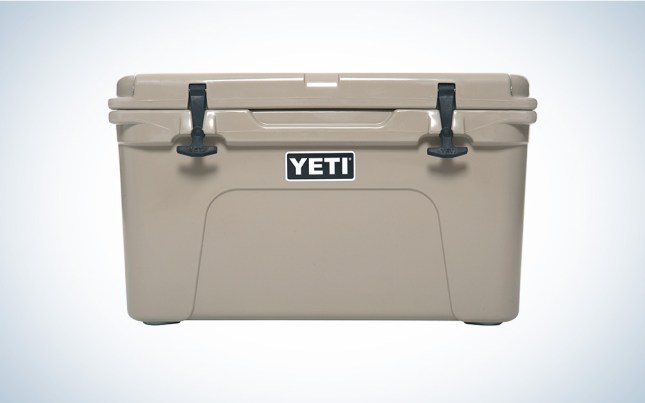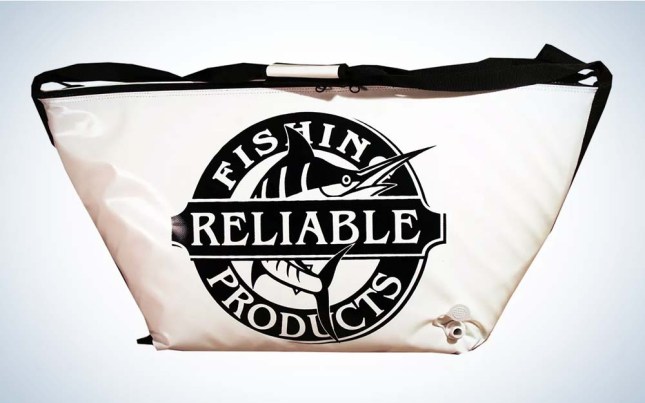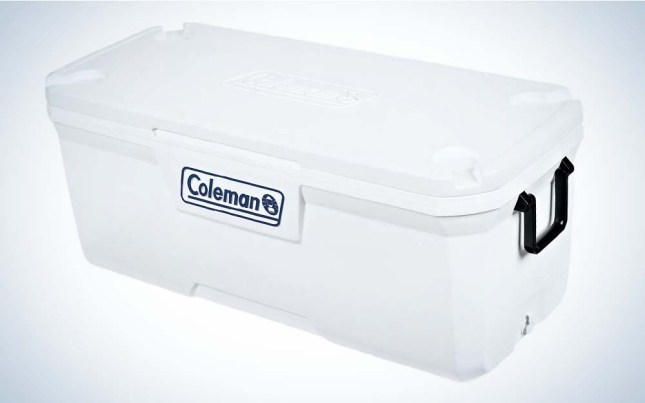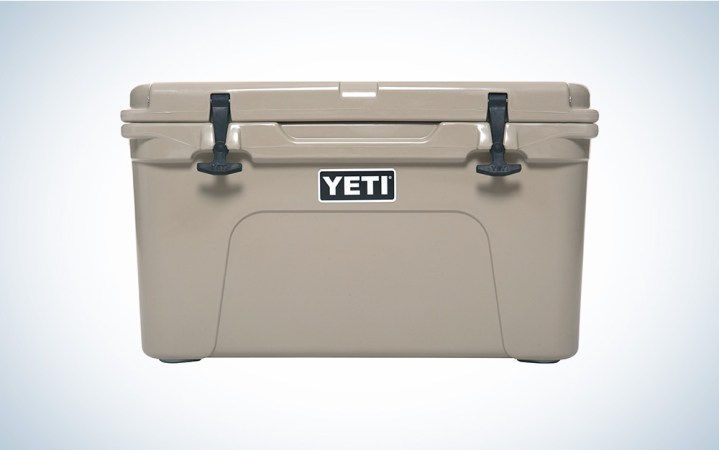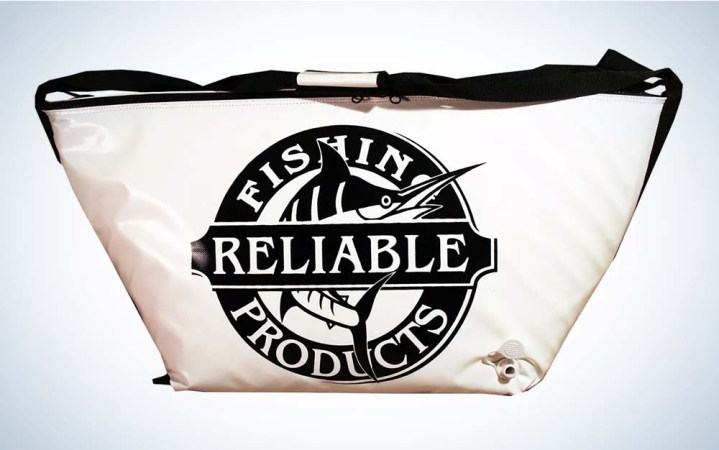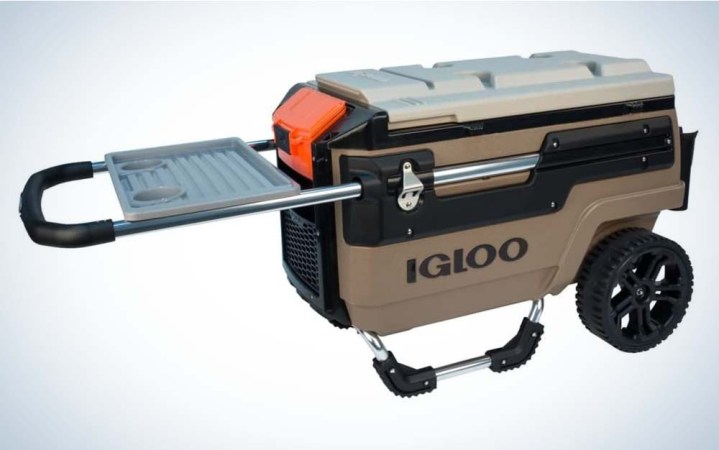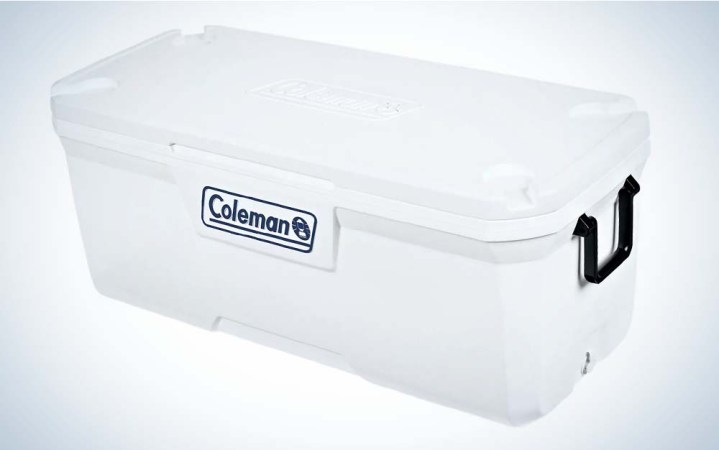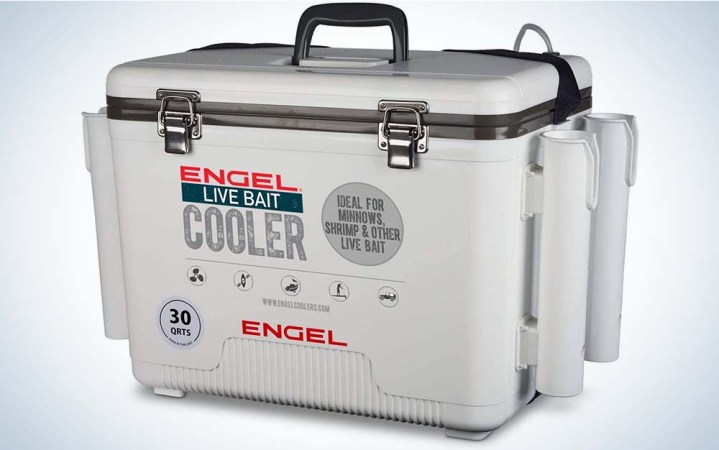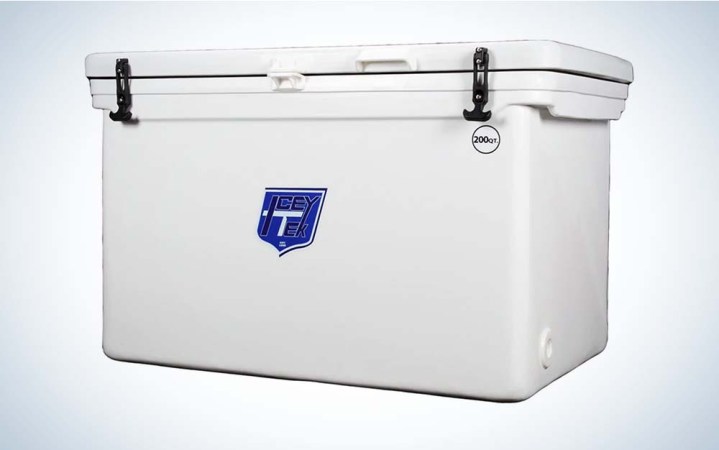We may earn revenue from the products available on this page and participate in affiliate programs. Learn More ›
Not long ago, the best fishing coolers were all the same: plastic, unreliable, and cheap. Today, coolers come in many colors and last for years, but cost a lot more money. The trade off for the price is improved durability and ice retention that make them worth every penny. With so many great coolers on the market, how do you separate the good from the great? I lined up the best fishing coolers and put them through a series of tests to see which models came out on top. Here are my top picks.
- Best Overall: Yeti Tundra 45
- Best Small Size: Reliable Fishing Products Kill Bag
- Best with Wheels: Igloo Trailmate Journey
- Best Budget: Coleman 316 Series
- Best with Rod Holders: Engle 30 Drybox/Cooler
- Best Large Size: Icey-Tek 200
How I Tested the Best Fishing Coolers
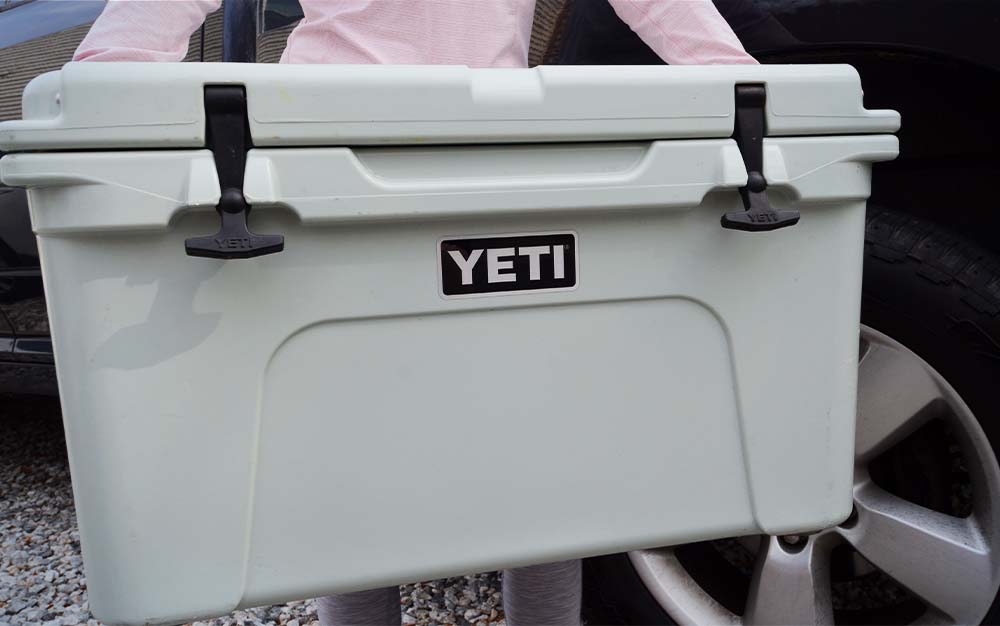
For this review, I tested the best fishing coolers by putting them through a tough day on the water. First, I filled them with ice and to see how long they kept the contents cold, and then I loaded them up and went fishing. To measure capacity and performance, I loaded the coolers with bait and my catch. I opened and closed the latches repeatedly, pulled on the lid to pressure the hinges, spent hours carrying and dragging the cooler by its handles, and finally washed fish guts, blood, scales, and slime from the outside and inside. As much as I hate to admit it, I even dropped and banged the cooler from the back of the truck to the bow of the boat. This treatment may seem extreme, but it’s not that different from a typical day on the water. And if you’re not rolling with the best fishing coolers, yours might not make it through many fishing trips.
Best Fishing Coolers: Reviews & Recommendations
Best Overall: Yeti Tundra 45
Key Features
- Weight: 23 pounds
- Exterior Dimensions: 25.5 x 16 x 15.5 inches
- Capacity: 45 quarts
Pros
- 3 inches of insulation
- Rubber lid gasket
- Unbreakable hinge
Cons
- Expensive
- Heavy
The Yeti Tundra started the premium cooler trend. With a tough, roto-molded-plastic body and three-inches of advanced insulation, the Tundra 45 provides unmatched ice retention. A freezer-style gasket and overlapping lid create an airtight seal to keep cold inside and hot air outside.
The little details set the Tundra apart. On a rocking boat, rubberized foot pads and tie down slots keep the cooler in place, and the cooler comes with molded handles for heavy lifting and rope handles to carry to the boat. My favorite feature on the Yeti Tundra is the Vortex drain plug. The plug screws into the cooler body so there’s nothing to break, and holes in the plug allow water to drain without unscrewing it all the way. Even after using my Yeti Tundra 45 for several years, the cooler looks and performs like new without any cracking, warping, or discoloration.
Best Small Size: Reliable Fishing Products Kill Bag
Key Features
- Weight: 8 pounds
- Dimensions: 20 x 48 inches
- Capacity: 85 quarts
Pros
- UV and mildew resistant
- Heavy-duty vinyl-coated polyester
- Sealed YKK zipper
Cons
- Doesn’t maintain ice as well as a hard cooler
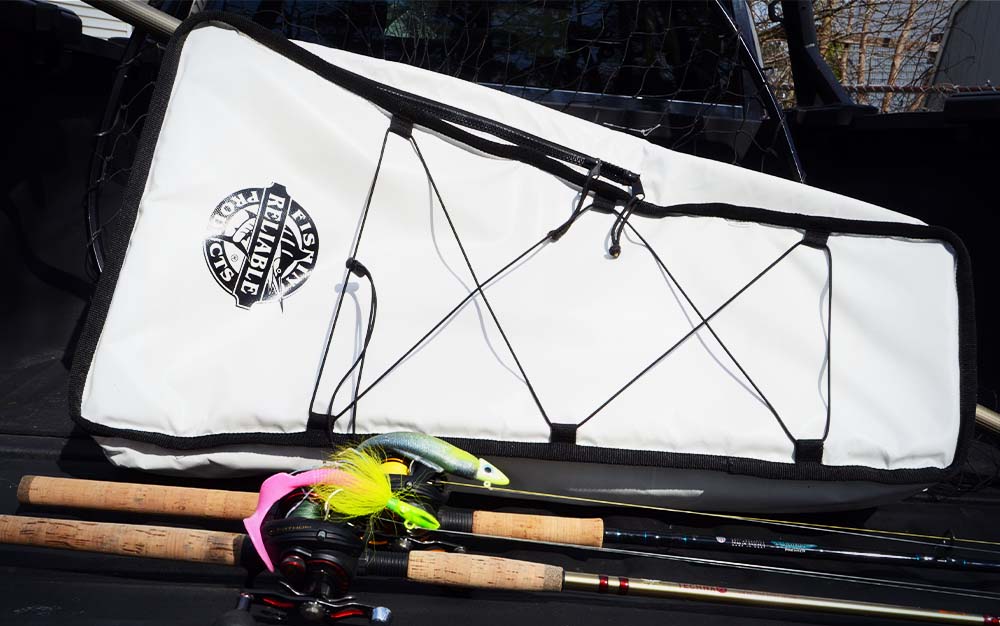
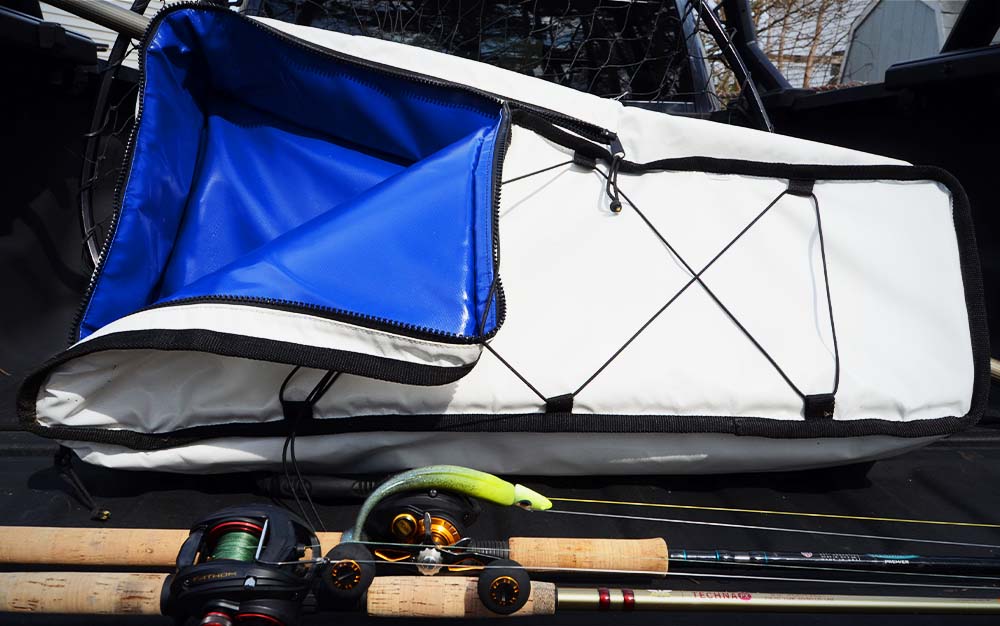
If you fish on a small boat and don’t have room for a full-size fish box, the Reliable Fishing Products Kill Bag is the perfect solution. It also makes a great option when you catch a fish larger than your fish box. You can pull out the vinyl-coated polyester soft-sided cooler, add a little ice, and slide the fish inside. High-quality, leak-proof zippers keep the cold and fish slime inside. The bag is pleated and gusseted to fold flat or stand upright, and the best feature is the drain plug, an unusual but fantastic addition for a soft-sided cooler.
Best with Wheels: Igloo Trailmate Journey
Key Features
- Weight: 34.7 pounds
- Dimensions: 34.59 x 19.7 x 23.61 inches
- Capacity: 70 quarts
Pros
- All-terrain wheels
- Elevated cooler
- Aluminum handle
Cons
- Bulky
When the fishing hole is down a path, over a hill, through a river, and across the beach, grab the Igloo Trailmate Journey cooler and hit the trail. To keep the cooler rolling, two over-sized, corrosion-resistant wheels cover soft ground and roll over rocks and logs. An aluminum handle makes it easy to control the heavy cooler but conveniently stows away to save space. You can also convert the handle into a work space when you add the included serving tray. When it’s time to go, the serving tray stores in the underside of the lid. The Trailmate Journey has a dry storage compartment, gear pockets, and a bottle opener for those times when the fish aren’t biting. Stainless steel hardware and aluminum components ensure that the Trailmate Journey keeps rolling for many miles.
Best Budget: Coleman 316 Marine Cooler
Key Features
- Weight: 34 pounds
- Dimensions: 18.53 x 20.4 x 45.1 inches
- Capacity: 150 quart
Pros
- Budget friendly
- Built-in ruler
- Antimicrobial-treated, stain-resistant interior
- Six-day ice retention
Cons
- Heavy
The classic white Coleman 316 Marine Cooler is a fixture on fishing boats around the world. Light, inexpensive and versatile, this cooler can take a beating on a boat or the back of a truck. The 150 quart model has space for the biggest fish or a week’s supply of food and beverages and contains a UV resistant coating to prevent the plastic from breaking down, warping, or fading. To serve as an extra seat, the lid can hold up to 250 pounds. Inside, an antimicrobial coating keeps the cooler mold and stain free. For just over $100, the Coleman
316 Marine Cooler has huge capacity, simple features, and reliable ice retention for a great fish box at a reasonable price.
Best Fishing Cooler with Rod Holders: Engle 30 Quart Leakproof Cooler/Drybox
Key Features
- Weight: 8 pounds
- Dimensions: 18.5 x 12.5 x 14.5 inches
- Capacity: 30 quarts
- Includes two speed aerator
- Four rod holders
Pros
- Compact design
- Leak-proof seal
- Tough injection-molded shell
Cons
- Less ice retention than similar coolers
Do you need a dry box, leak-proof cooler, and a live well with rod holders? You get it all with Engle’s 30 Quart Dry Box/Cooler. It’s compact enough for kayak fishing, loading onto an ATV, or carrying to your favorite distant fishing spot. The 30 Quart Dry Box/Cooler can accommodate a day’s worth of bait or lunch for the family. Four vertical rod holders keep rods in place for easy transport. You can even trust the dry box to protect camera equipment and electronics during stormy, wet conditions. It’s so reliable that I trust it as my favorite lunch box. The Engle cooler/dry box doesn’t have a drain plug, and the lid is sealed and latched so there’s no danger it will leak even if it flips upside down. For anglers who want to keep minnows or leeches alive, this is an ideal option. It comes with a battery powered aerator that bubbles the bait inside. It will keep even the most sensitive crappie minnows alive during a long day on the water.
Best Large Fishing Cooler: Icey-Tek 200 Quart
Key Features
- Weight: 48 pounds
- Dimensions: 38.25 x 26 x 24.5 inches
- Capacity: 200 quarts
Pros
- Roto-molded plastic
- Heavy-duty hinges
- Dry ice compatible
Cons
- Not the flashiest
The ICEY-TEK 200 emerged in the late 80s as one of the first high-performance coolers and the rugged fish boxes are still popular with pro anglers and commercial fishermen. With models up to 1100 quarts, ICEY-TEK offers sturdy roto-molded plastic and high-density insulation that can handle even your largest hauls. While their appearance might not wow anyone, these coolers are all performance.. The simple, boxy, white design emphasizes ice retention and durability with a marine-grade gasket and UV-resistant stretchy rubber latches to seal in cold air. Molded handles under the lid make the huge cooler easy to carry. Two large drain plugs remove meltwater and make clean-up easy. You can even lock the lid on the ICEY-TEK 200 for an equally capable dry storage locker.
Read Next: The Best Fillet Knives of 2023, Tested and Reviewed
Things to Consider Before Buying a Fishing Cooler
I have to admit, I’m a cooler snob. I have 15 coolers stacked in my garage and a couple more outside. No matter where I fish, a fishing kayak, motor boat, and shore, I have the best fishing coolers everywhere I go. My collection continues to grow and includes soft coolers, coolers with wheels, budget models, and high-dollar brands.
This cooler addiction started a few years ago when I had to replace the 120-quart fish box in my boat. For over a decade, I used and abused tons of less expensive marine coolers. Inevitably, I would break the hinges, snap the latches and eventually crack the outer layer and expose the yellow foam inside. Each time I replaced my fishbox, I would consider one of the premium models. Then, I would see the $700 price tag and chicken out, but after my third cheap fish box, I decided to bite the bullet, and I coughed up the extra dough and bought the best fishing cooler in the store.
While there are some downsides, like extra weight and reduced capacity, the advantages of the best fishing coolers outweigh them. Since then, I’ve set a new bar for keeping my catch and my lunch cool. In this review, I share what I learned about choosing the best fishing coolers so you don’t have to waste time or money on anything less.
Construction
The biggest improvement in fishing coolers is durability. Modern coolers feature sturdy hinges molded into the cooler body with a corrosion-resistant rod. The cooler shell is made of roto-molded plastic that is nearly indestructible and easy to repair, and the latches are tough and secure enough to offer easy access without accidentally breaking or opening. I prefer low-profile hinges and latches that take less space in the boat and won’t snag my clothes. Most importantly for anglers, the best fishing coolers are easy to clean, because the outside and inside of the cooler is smooth enough to shed fish blood and guts. One of the biggest downsides, though, is weight. Many premium coolers are a little heavier than the old white-plastic fishing cooler, but this is a tradeoff for added insulation and sturdier construction. So, don’t be surprised to find that your top-tier fishing cooler is heavier and bulkier than an old-school cooler of the same capacity.
Ice Retention
The most important job of a fishing cooler is to keep the contents cold. While any cooler will hold enough ice for a day on the water, the best fishing coolers maintain temperature for longer with less ice. The latest generation of super coolers brag about how long ice lasts. Pack the best coolers on our list with cube ice, and the contents will still be frozen five or more days later. This is great for maintaining ice on a camping trip or multi-day fishing expedition. Even for a day-long fishing trip, these efficient coolers require 30 percent less ice than leaky, drafty old coolers.
During the course of a fishing trip, opening and closing the cooler lid and filling it with fish lets in heat and quickly melts ice. To improve ice retention, the best fishing coolers use thicker and heavier insulation, and the lid is sealed with a gasket to prevent hot air from entering the cooler when it’s shut. Quality latches are key to getting the most out of the best cooler, and they should have a tight fit to completely seal the contents.
Cost
Premium prices are probably the biggest barrier if you’re considering an advanced cooler. While the best budget cooler comes in at around $100, the same-size premium cooler might cost four-times as much. Don’t let sticker shock keep you from investing in one. The best fishing coolers will last way longer than a cheaper model. You won’t have to replace hinges, handles, or latches either. And, with a premium cooler, you can buy less ice and expect it to last longer.
FAQs
Generally, it’s a good idea to have a cooler for fishing. Not only does a cooler keep your bait and catch cool, but the best fishing coolers also preserve food and beverages and serve as dry storage for gear. As soon as you land a fish you plan to eat, it is important to put the fish on ice. Cooling the meat prevents bacteria growth and improves the meat’s texture and firmness. Cleaning a cold fish is a lot easier, too, because it’s firmer and easier to cut and remove from the bones. If you release your catch, you’ll still need the best fishing cooler to keep your lunch and beverages cold.
A good size cooler for fishing depends on your intended use and purposes. In addition to external dimensions, coolers are classified by their capacity. A ten quart cooler is big enough for bait or lunch, while a 150-quart cooler is a standard fish box for an offshore fishing boat. To determine the size fish cooler you need, measure the space where the cooler sits to make sure it can hold the one you have in mind. Coolers come in many different dimensions. A 100 quart cooler by one company may not fit in the same space that a 100 quart cooler from another company. In addition to the cooler’s outer dimensions, look for a room inside to fit your catch.
When I store fish, I prefer a cooler that’s long enough for the fish to lie flat without bending. For example, speckled trout and redfish average 20 to 25 inches, so I look for a 30-inch-long cooler to accommodate my catch. If you primarily target panfish, a 50-quart cooler will hold a day’s limit. On my 20-foot center console boat, I have a 120 quart fish box and a 35 quart lunch cooler. To store bait, I use an eight-quart soft cooler to hold a frozen ice pack and my day’s supply of squid, clams, and cut bait. I stick the smaller cooler into my 120 quart fish box and frozen bait stays solid all day.
The cost of the best fishing coolers depend on the brand and capacity.Instead of repairing and replacing a cheap fishing cooler, anglers want a cooler that will last for years without fail. But sturdy components, a durable shell, and days of ice retention come at a price. Depending on the size, the best fishing coolers typically run north of $200, but the performance and reliability make these high-dollar coolers worth the money. Not only will the cooler endure years of abuse, but it’ll also hold ice longer and save time and money in the long run.
I recently replaced a 120 quart marine cooler with a same-size premium cooler. The new fish box is easier to clean, holds more fish with 30 percent less ice, and doesn’t need a repair every time I go fishing. I spent years avoiding expensive premium fishing coolers trying to save money but ended up losing more in the long run. Treat your cooler like an investment and you’ll save a lot of time and money.
Why Trust Outdoor Life?
Since 1898, OL has been a leading authority in testing and reviewing hunting gear, fishing tackle, guns and shooting equipment, and much more. We have more than a century-long history of evaluating products, and we’re now bringing that expertise to online reviews. Our editors are experienced outdoorsmen and women, and most importantly, we’re trained journalists. We prioritize field testing and objective data when reviewing products. We conduct interviews with gear manufacturers and engineers as well as outdoor experts so that our readers have an understanding of how and why a product works—or doesn’t.
Advertising does not influence our gear reviews and it never will. While we always focus our coverage on standout products—because we want our readers to be aware of the latest and greatest gear—we also cover the flaws and quirks of any given product.
Final Thoughts
Buying an expensive cooler might seem intimidating at first, and there are plenty of ways to talk yourself out of it. Trust me. But if you spend enough time on the water, having the best fishing cooler isn’t just an investment in your gear, it’s an investment in your fishing. And if you want to maximize your time on the water, a quality fishing cooler is a great place to start.
- Best Overall: Yeti Tundra 45
- Best Small: Reliable Fishing Products Kill Bag
- Best with Wheels: Igloo Trailmate Journey
- Best Budget: Coleman 316 Series
- Best with Rod Holders: Engle 30 Drybox/Cooler
- Best Large: Icey-Tek 200
